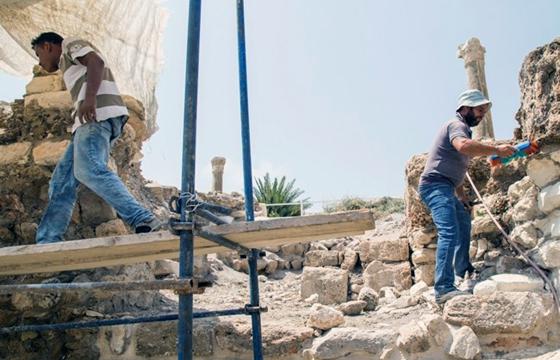Italian and Lebanese archaeological restoration experts pooled their abilities this week to preserve Lebanon’s UNESCO World Heritage sites. The four day workshop, organized by the Italian Trade Agency and the Italian Association for Art and Urban Restoration (Assorestauro), drew architects and archeologists from around the region.
Italian companies specializing in reconstruction projects also participated in the discussion of conservation methods from their homeland and how to apply them to in Lebanon. “We want to show the Lebanese people how we can provide some sort of intervention with projects coming from Italy,” Cecilia Zampa, Vice President of Assorestauro, told The Daily Star.
Thursday’s focus was on the “City Site” in Tyre, one of five UNESCO World Heritage Sites in Lebanon, and part of the Baalbeck and Tyre Archaeological Project – an ongoing initiative to restore structures that are significant to Lebanon’s cultural history.
Two Italian contractors are currently working on the restoration project, but the workshop gave Lebanese architects and archaeologists an opportunity to learn more about techniques from across the Mediterranean. “We would like, as much as possible, to get this experience here in Lebanon,” Ali Badawi, manager of City Site for the Director General of Antiquities, told The Daily Star.
The City Site is a remnant of Tyre’s Roman past when Alexander the Great conquered Phoenician lands and created a land-bridge, which connected the former island to the mainland. At the end of the site lies a harbor that is submerged into the Mediterranean and once connected Tyre to the Roman Empire.
But despite shared history with Italy as part of Alexander the Great’s empire, Lebanon’s distinct cultural background requires local expertise to most effectively utilize modern conservation methods. “We want to understand the Lebanese requirements and our capabilities to handle their needs,” Zampa said.
Palm trees and white columns towered in the background as a group of Lebanese architects, archaeologists and professors huddled around a demonstration of highly specialized laser cleaning technology in Tyre Thursday. “Some of this expertise, unfortunately, we don’t have in Lebanon,” Badawi said.
While some of the technologies discussed are highly specialized, most of the work conducted by Italian and Lebanese conservationists alike still requires essential skills to clean delicate surfaces with water and a brush by hand.
For Roland Haddad, a Lebanese architect working on the project, attention to tradition and cultural history in site planning is essential in his role as a local subcontractor.
Looking out over the eastern corner of the site, Haddad points to the now rehabilitated site that he said used to be overrun with vegetation when the project started.
“When you do a [site] design, you [have to] imagine it wasn’t like this [before],” he said.
While experts at this week’s conference focused on the preservation of Lebanon’s sites, Badawi said honing these methods would also prepare architects for future projects in Iraq and Syria, where UNESCO sites are under threat from ongoing conflicts. Syrian and Iraqi conservationists and architects met with their Lebanese and Italian colleagues to discuss the situation in their countries where archaeological work is currently impossible. “Lebanon is the base where they are educating those people,” Badawi said. “They are trying to get some benefit from the Lebanese experience.”
Bringing techniques from the land of the Pantheon to Lebanon’s rocky coast and beyond, the workshop combines expertise with wide scale regional knowledge to make sure preservation methods are sustainable. “Conservation is not reversible.” Badawi said. “If you make a mistake, you will lose the monument.
The Daily Star























































